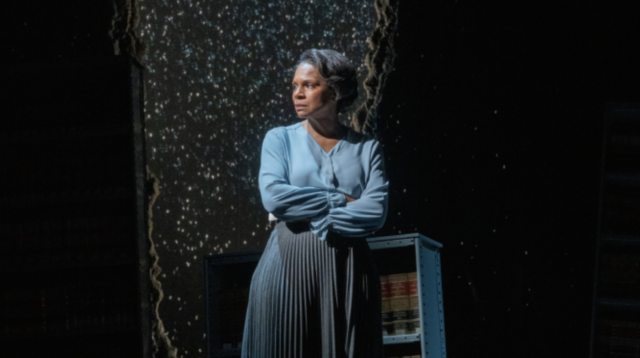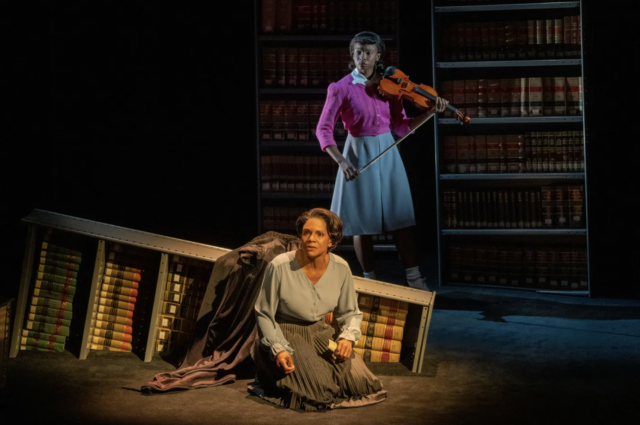
Audra McDonald stars in Adrienne Kennedy’s long-in-coming Broadway debut, Ohio State Murders (photo by Richard Termine)
OHIO STATE MURDERS
James Earl Jones Theatre
138 West Forty-Eighth St. between Sixth & Seventh Aves.
Tuesday – Sunday through January 15, $114-$244
212-362-7600
www.lct.org
One of my favorite virtual presentations during the pandemic lockdown was “The Work of Adrienne Kennedy: Inspiration & Influence,” a collaboration between DC’s Round House Theatre and Princeton’s McCarter Theatre Center, a deep dive into the career of playwright Adrienne Kennedy, who was born in Pittsburgh in 1931 and has only recently become more well known for her outstanding oeuvre. The Round House and McCarter hosted panel discussions and staged excellent recorded productions of He Brought Her Heart Back in a Box, which made its world premiere at TFANA in 2018; Kennedy’s very personal 1996 play, the Obie-winning Sleep Deprivation Chamber, which she wrote with her son, Adam P. Kennedy; the world premiere of Etta and Ella on the Upper West Side, adapted from a 1999 story; and 1992’s Ohio State Murders, one of Kennedy’s Alexander Plays, featuring her alter ego, writer Suzanne Alexander. (Chicago’s Goodman Theatre also put on an exemplary livestreamed version of Ohio State Murders.)
I was excited when I heard that Ohio State Murders would mark Kennedy’s Broadway debut, at the age of ninety-one, in a new production starring six-time Tony winner Audra McDonald and inaugurating the James Earl Jones Theatre (previously the Cort), named after the ninety-one-year-old award-winning actor. And then I was devastated to find out that the show would be closing about a month early, shutting down January 15 instead of February 12 (following a December 8 opening), despite mostly rave reviews, the latest in a series of notable Black plays posting early closing notices since the end of the lockdown, including Ain’t No Mo’, for colored girls who have considered suicide/when the rainbow is enuf, Chicken & Biscuits, and Thoughts of a Colored Man. I was even more shocked after seeing Tony winner Kenny Leon’s splendid production.
As the audience enters the theater, a recording of a 2015 interview with Kennedy, conducted by her grandson, Canaan Kennedy, plays on a loop, with the playwright talking about her life and career, focusing on having a family and studying and teaching at universities. Beowulf Boritt’s intellectual set consists of more than a dozen bookshelves at multiple angles, on the floor and hanging from the ceiling, as if Alexander is surrounded by an education that will not be available to her or other Black people. A metaphoric chill is in the air from a tear on the back wall through which appears a video projection of falling snow.
Ohio State Murders takes place at Ohio State University in Columbus, where Kennedy earned her BA. The frame story is that Suzanne has returned to Ohio State to give a lecture. She begins: “I was asked to talk about the violent imagery in my work; bloodied heads, severed limbs, dead father, dead Nazis, dying Jesus. The chairman said, we do want to hear about your brief years here at Ohio State but we also want you to talk about violent imagery in your stories and plays. When I visited Ohio State last year it struck me as a series of disparate dark landscapes just as it had in 1949, the autumn of my freshman year.”

Audra McDonald shifts between past and present in Ohio State Murders at James Earl Jones Theatre (photo by Richard Termine)
Suzanne goes on to share a heartbreaking tale of what happened to her at the school, involving a white English professor, Robert Hampshire (Bryce Pinkham), her violin-playing roommate, Iris Ann (Abigail Stephenson), her landlady, Mrs. Tyler (Lizan Mitchell), dorm head Miss Dawson (Mitchell), Aunt Louise (Mitchell), close friend Val (Mister Fitzgerald), and law student David Alexander (Fitzgerald), who will become her husband. Hampshire has a particular fondness for Thomas Hardy’s Tess of the d’Urbervilles, which deals with a rape/seduction and a strong-willed woman, and King Arthur, about whom Hampshire reads, “‘Till the blood bespattered his stately beard. / As if he had been battering beasts to death. / Had not Sir Ewain and other great lords come up, / His brave heart would have burst then in bitter woe: / ‘Stop!’ these stern men said, ‘You are bloodying yourself!’ ” Meanwhile, Suzanne is deeply affected after seeing Sergei Eisenstein’s 1925 silent classic, Battleship Potemkin, about the 1905 Russian Revolution. Tess, Arthur, and the film all relate to Suzanne’s personal experience at college and illuminate the sources of her violent imagery.
McDonald (Lady Day at Emerson’s Bar and Grill, Frankie and Johnny in the Clair de Lune) is marvelous as Suzanne, a role usually performed by two actors, one in the present, one in the past. (The original had Ruby Dee and Bellary Darden, while Lisagay Hamilton and Cherise Boothe shared the part in the New York premiere from TFANA in 2007.) Despite the tragedies and disappointments that hover around Suzanne, McDonald portrays her as remarkably even-tempered, almost to the point of being detached from the horrific truth. She weaves between 1950 and today with a graceful ease and a mere adjustment to her costume (a button-down blouse and long skirt, designed by Dede Ayite). Tony nominee Pinkham (A Gentleman’s Guide to Love & Murder, Love’s Labour’s Lost) is calm and steady as Hampshire, who hides a dark secret. It’s always a pleasure to see Mitchell (On Sugarland, Cullud Wattah), who switches between three roles.
Tony winner Leon (Topdog/Underdog, A Soldier’s Play) maintains a gentle, almost frustrating pace, giving room for Kennedy’s words to tell the story without melodramatic embellishment. Justin Ellington’s sound and Allen Lee Hughes’s lighting enhance the mysterious atmosphere that pervades the play, along with Jeff Sugg’s projections and Dwight Andrews’s original music.
Following the curtain call, which includes the cast honoring a large photograph of Kennedy, the interview starts again. As with the rediscovery of Alice Childress, the Charleston-born Black playwright who made her posthumous Broadway debut last season with 1955’s Trouble in Mind, followed shortly by TFANA’s production of her 1966 drama Wedding Band: A Love/Hate Story in Black and White, Kennedy’s is a voice that deserves to be heard, must be heard; her plays, many of which are experimental and challenge traditional narrative techniques, shine a light on racial injustice in America over the last half century and more, up to today. See Ohio State Murders on Broadway while you still can and help celebrate Adrienne Kennedy while she is still with us.